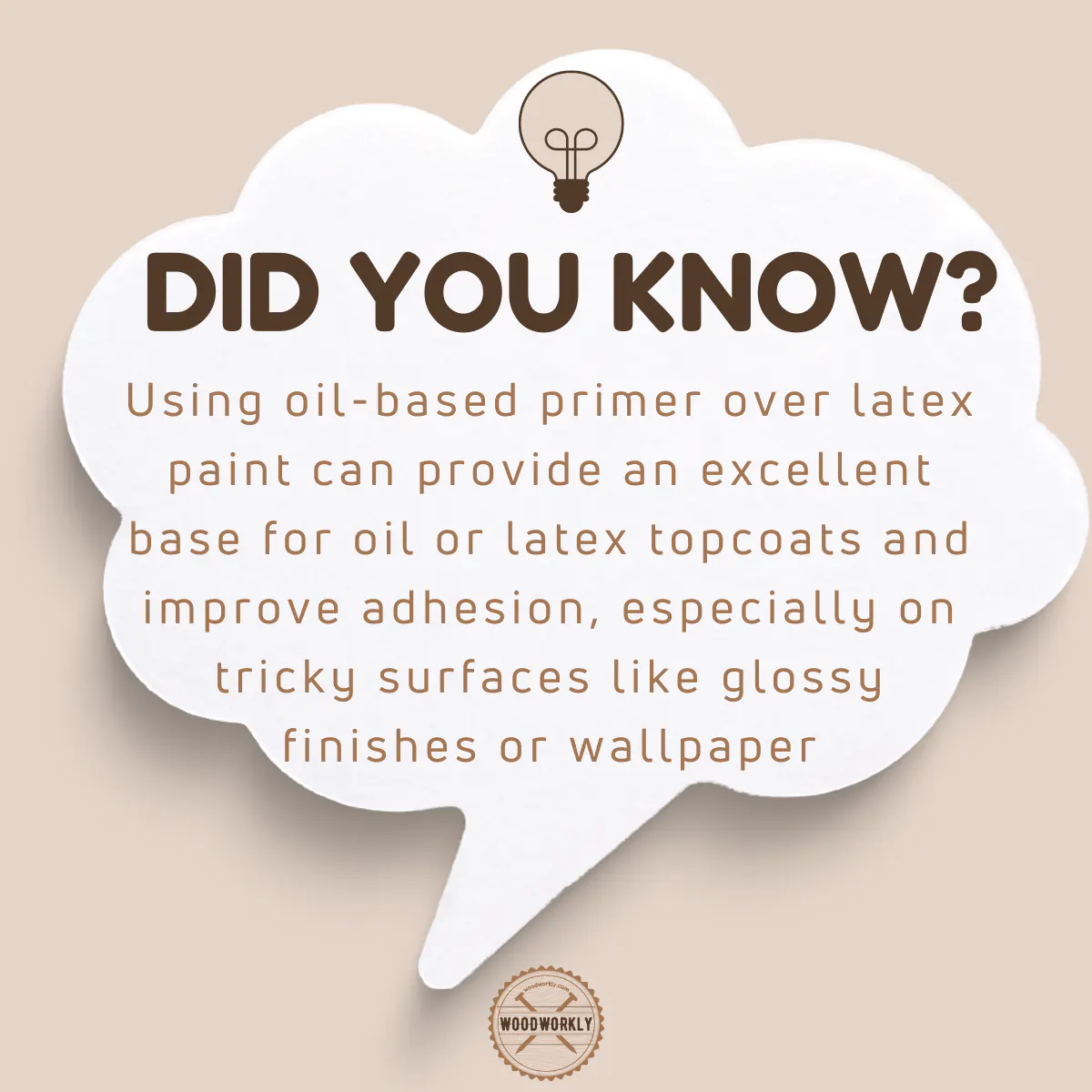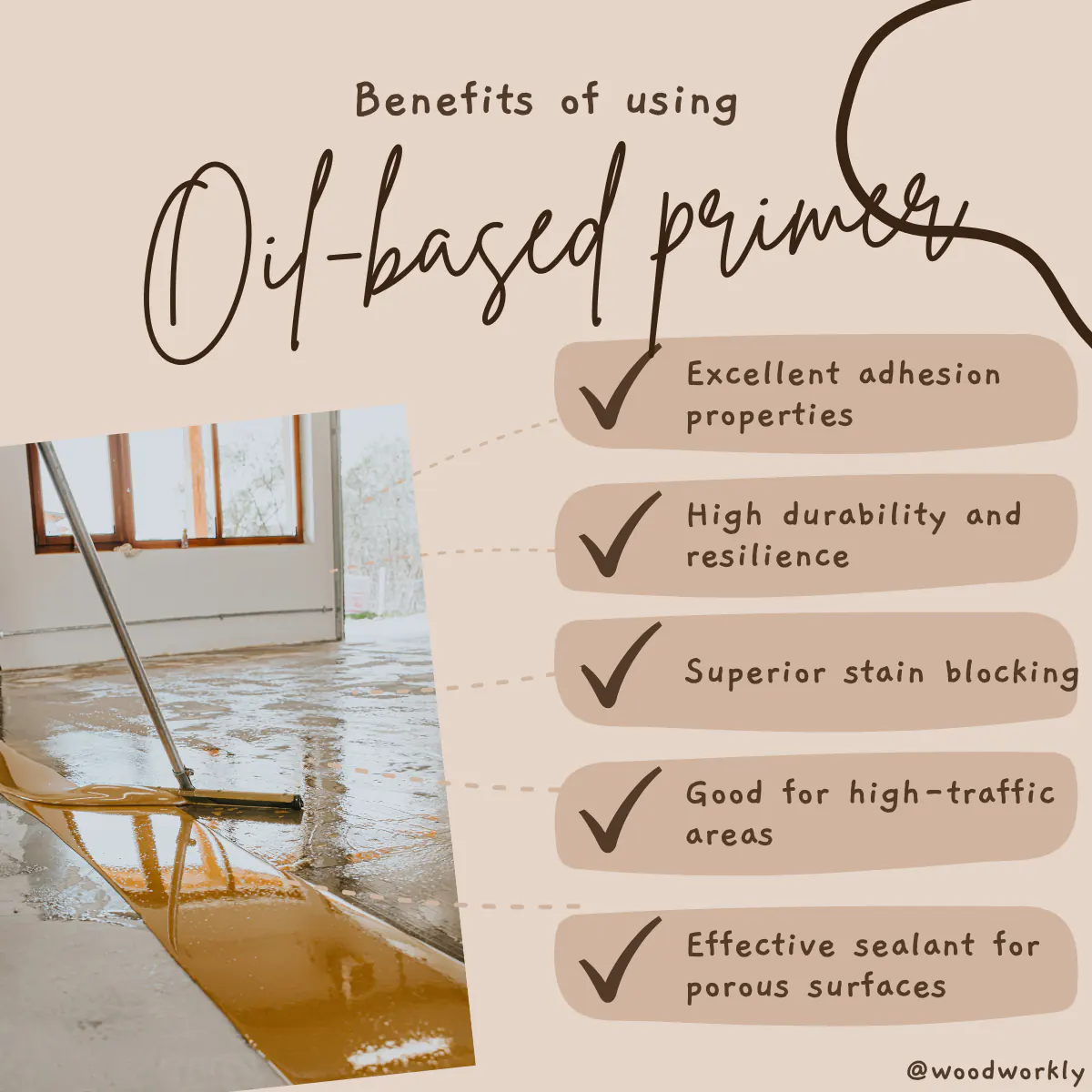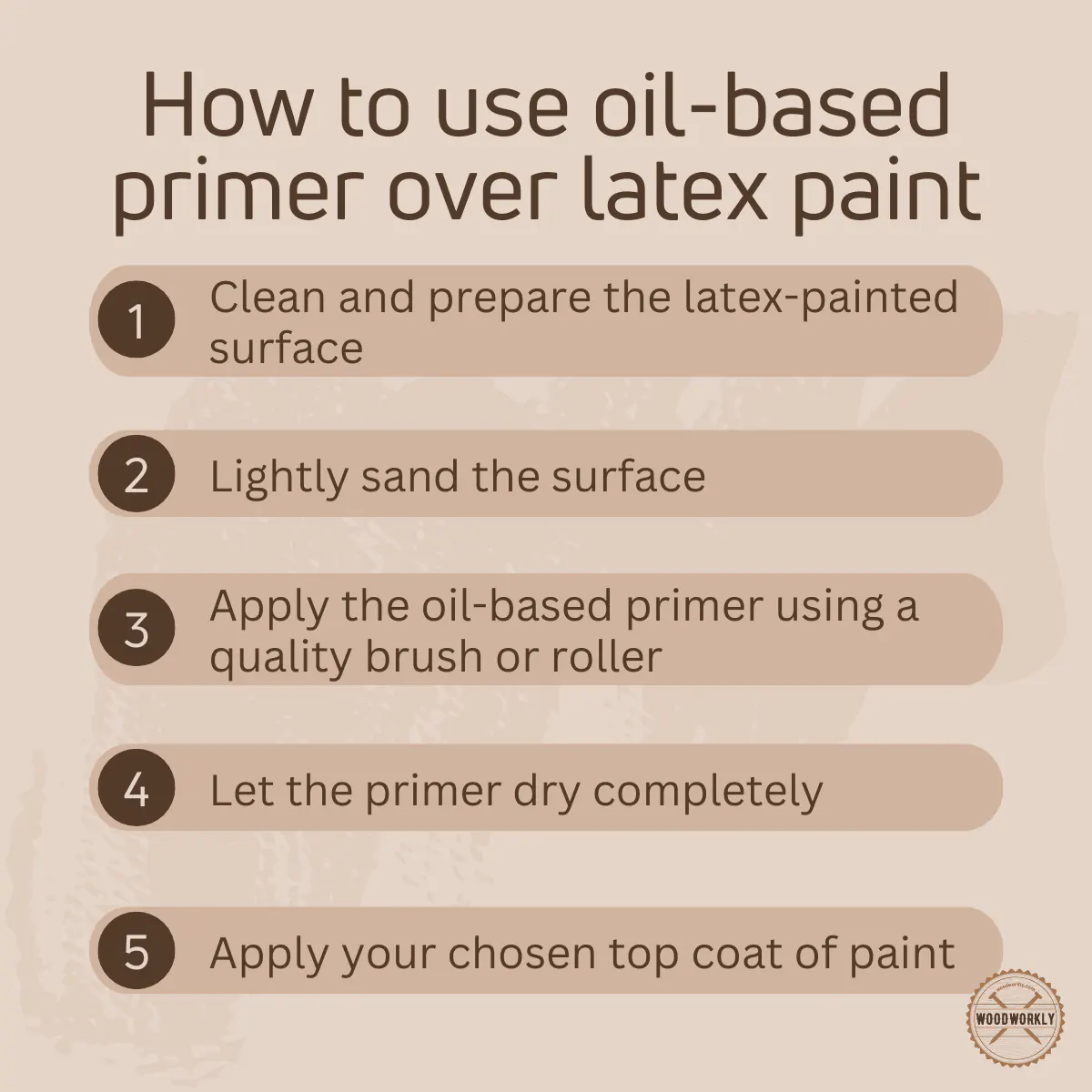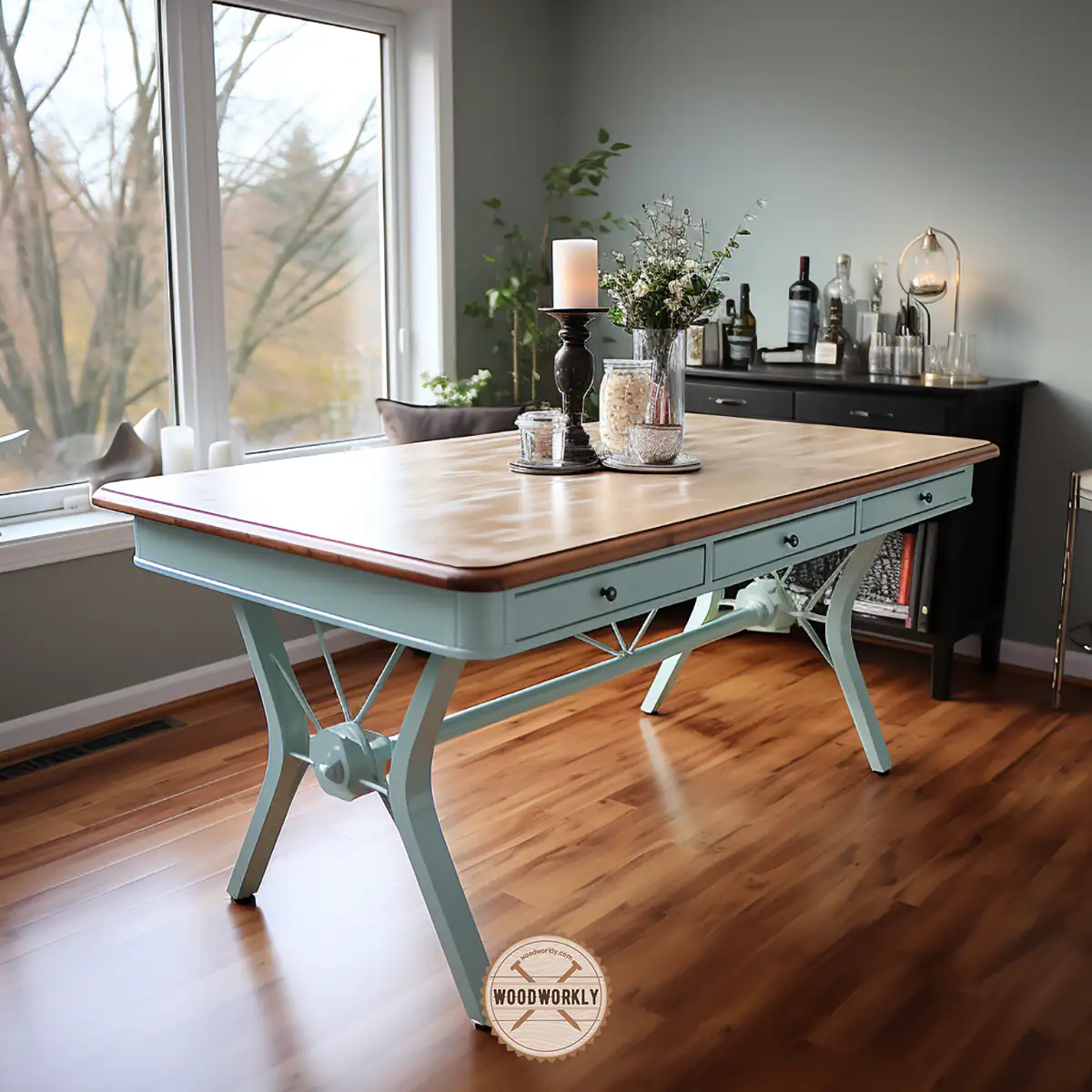Ever painted a wall and it just didn’t turn out as you’d hoped? Could using an oil-based primer over latex paint be your solution? Let’s unravel this mystery together.

Oil-based primers are mainly used to prepare surfaces for painting.
They are excellent for blocking stains, preventing rust, sealing porous surfaces, and providing a stable base for topcoats of paint.
I usually work more with latex-painted woodwork and furniture and I was curious about applying an oil-based primer over latex paint.
I did some research about this with my fellow woodworking experts and able to gain an excellent solution.
Now, here’s what I know about, Can you use oil based primer over latex paint?
Yes, you can use oil based primer over latex paint only if the surface is prepared properly. Clean and sand the latex-painted surface well before applying the oil-based primer. Otherwise, oil based primer will not adhere properly to latex paint and lead to cracking or peeling.
But there’s more to know about using oil-based primer over latex paint. Plus, surface preparation is not hard as you think!

So, in this article, I’ll explore can you use oil-based primer over latex, what happens if you put oil-based primer over latex paint, how to apply and many more.
Furthermore, I’ll answer some frequently asked questions as well.
Let’s jump in!

What Happens If You Put Oil-Based Primer Over Latex Paint?
When you put oil-based primer over latex paint the latex paint causes it to crack or peel due to incompatible movements of oil-based primer and the latex paint.
This happens due to weather changes.
Oil-based primer tends to expand and contract over time due to weather. But the latex underlaying paint doesn’t expand and contract at the same rate as oil-based primer does.
As a result of this, the bond between the latex paint and oil-based primer will break and crack the surface.
If the oil-based primer and latex paint expand and contract at an equal rate due to weather fluctuations, there won’t be an issue.
Therefore, if you live in an area that has weather changes on a regular basis, better not to apply oil-based primer over latex paint.
But with a well-prepared surface and under normal weather conditions oil-based primer can go over both interior and exterior latex painted surfaces so well.

So, let’s find out how to use oil-based primer over latex paint with simple steps.
First of all grab the supplies you need.
The Supplies You Will Need To Use Oil-Based Primer Over Latex Paint
- Latex paint
- Oil-based primer
- Soft lint-free cloths
- Paintbrushes
- Latex gloves
- TSP solution (Tri sodium phosphate)
- Warm water
- 220 grit sandpaper
- 150 grit sandpaper
Tip:
If you are unable to find TSP, use soapy water to clean the surface.

How To Use Oil-Based Primer Over Latex Paint?
Using oil-based primer over latex paint is critical. Because the surface needs to be well cleaned and smooth before applying latex paint over oil-based primer.
Otherwise, you’ll face compatibility issues in two layers.
Here’s the procedure you need to follow when using oil-based primer over latex paint,
- Clean the surface
- Sand the wood surface
- Apply Latex Paint
- Let the surface dry
- Sand the surface
- Apply oil-based primer
- Let the wood dry completely
By following the above steps even, a beginner in woodworking can do the job perfectly.
So, dive in deeper and discuss each of the above steps one by one.
1. Clean The Surface
This is one of the most important steps in any woodworking or wood-finishing project.
The wood surface needs to be cleaned and free from dust to accept latex paint. Otherwise, dust and debris will get trapped inside the paint and your whole woodwork can be ruined.
Clean the wood with TSP and warm water and wipe down the surface with a clean, soft cloth.
Make sure to cover up the entire surface without missing any spots. Or you can use soapy water and a piece of cloth to remove dust and dirt.
By using TSP over soapy water you’ll be able to remove dirt that hardly sticks to the surface.
You have to make sure the surface is free from dust, debris, grease, oil, and other residues before applying the first coat of latex paint.
When you’re done cleaning the wood with soapy water or TSP, leave it for a couple of hours to dry completely.
The average drying time after cleaning the wood is around 6 – 8 hours. Therefore better to leave the project overnight to dry.

2. Sand The Wood Surface
Now sand the entire wood surface with 220 grit sandpaper. Sanding is important to open pore structures of the wood which makes the wood fibers ready to accept latex paint effectively.
Sanding eliminates saw marks from manufacturing that cannot be seen by the naked eye.
Sand along the direction of the wood grain without scratching the surface with even pressure. Sanding helps latex paint to adhere to the wood surface properly.
If you’ve noticed wood holes or cracks while sanding the wood, make sure to fill and harden them up with a wood filler before sanding.
This is the final step you get to make the surface as you want before applying the latex paint.
Sanding will make the surface super smooth and nice.
When you’re done with sanding, clean the sawdust with a vacuum or wipe the surface with a clean, soft cloth to pick up and clean away the sawdust.
Remember not to leave any dust, debris, or residue before moving on to the next step.

3. Apply Latex Paint
First, stir the latex paint with a clean stick for a few minutes until the paint is well mixed.
Then dip the paintbrush into the latex paint can and apply the paint along the direction of the wood grain for better absorption.
Or you can use a paint roller to paint evenly and use a paintbrush only to paint the tight spots.
When you’re selecting latex paint, make sure it is fresh, thin, and free of air bubbles.
If the air bubbles are trapped inside, that will cause surface blotchiness and yellow, brown patches bleed through the paint.
Apply latex paint all over the surface evenly without missing any spots. Makes sure to apply a thin coat of latex to dry faster and avoid getting a tacky surface.
4. Let The Surface Dry
Once you’re done with painting, let it dry completely. The average drying time of latex paint is 72 hours.
Read the instruction manual to know the exact drying time because that varies according to the manufacturer.
Once the first coat of latex is dried completely, better to go for a second coat of latex and follow the same procedure to gain the best results out it.
The second coat covers all the aspects of the first coat of latex paint.
5. Sand The Surface
I know you’re probably wondering; can we sand the latex paint layer? Yes, we can. sand the latex-coated surface with 220 grit sandpaper.
This helps to remove bumps and other inconsistencies that occurred due to brush or roller.
But make sure to do a light sanding with a very little amount of pressure on sandpaper because excess pressure can damage the latex paint coat.
You need to be more careful in this step and patience is the key to success.
Sand lightly and don’t panic when you see some colors coming off. That’s totally fine until you’re not sanding the paint off.
Sand the whole surface and wipe down the leftovers with a clean cloth. Now the surface is ready to take on the oil-based primer.
The whole process that we have discussed above belongs to surface preparation. This is how you do it to apply oil-based primer over latex paint. Without proper surface preparation, the oil-based primer won’t adhere well to latex paint.
So, let’s see how you should apply oil-based primer over the prepared latex-coated surface.

6. Apply Oil-Based Primer
Mix the oil-based primer with a clean wood stick, dip the paintbrush into the oil-based primer and apply.
Primer gives the surface a fresh and nice look that’s aesthetically pleasing.
Oil-based primers adhere well with latex paint as long as you’re applying a thin coat of primer.
Apply primer with an even pressure evenly throughout the wood for better absorption.
7. Let the Wood Dry Completely
Once you successfully apply the primer, let the surface dry for about 8 hours to settle in.
Drying is important to absorb oil-based primer into the latex coat and make a strong bond between them.
As long as the bonds between two layers are strong enough, they cannot be separated.
Otherwise, oil-based primer expands and contracts faster than latex paint due to weather fluctuations which can cause latex paint to crack or peel.
The drying time of oil-based primer is only about 8 hours. But the curing time is around 14 days.
The reason for taking a much longer time for curing is that oil-based primers cure more slowly than regular ones. After 14 days, you’ll get a nice, polished look in your woodwork.
That’s it, folks! This is how to apply oil-based primer over latex paint without making any errors. This is the most simple and accurate method you can follow.

Can You Put Oil-Based Primer Over Water-Based Paint?
Yes, you can use oil-based primer over latex paint. But you have to make sure the water-based paint is dried completely before applying oil-based primer because oil and water don’t mix.
Prepare the surface by cleaning the surface, sanding, and applying water-based primer.
Then let it dry completely for about 6 – 8 hours and then apply oil-based primer.
Surface preparation is a must to avoid paint layers cause to crack or peeling.
What Is the Best Primer to Use Over Latex Paint?
Oil-based primer is best to use over latex paint because it adheres well with latex paint.
Here’re the best oil-based primer products that can use over latex paint.
- KILZ Interior
- Zinsser cover stain
- Rust-Oleum primer
- True Value premium Weatherall primer
- INSL-X Primer
Since KILZ oil-based primer is a popular one, I’ll show you how to use it over latex paint with my personal experience.

Can You Use KILZ Oil-Based Primer Over Latex Paint?
Yes, you absolutely can use KILZ oil-based primer over latex paint.
KILZ is a renowned brand in the painting industry and is noted for its excellent adhesion and coverage properties.
Why Choose KILZ Oil-Based Primer?
KILZ Oil-Based Primer is a great choice for a few reasons.
This primer is known for its strong adhesion, which makes it particularly useful for surfaces coated with latex paint.
The primer forms a secure bond with the latex paint, preparing it for the final topcoat and ensuring a more durable finish.
Example: Personal Experience with KILZ Primer
I remember a home renovation project where I faced the same dilemma.
The walls were previously painted with latex paint, and I was concerned about how an oil-based primer would interact with it. However, KILZ Oil-Based Primer was a game-changer.
The primer adhered to the latex paint seamlessly, providing a perfect base for the final layer of paint.
The finished result was flawless, with no signs of peeling or cracking, even after months.
Congrats folks! Now you know whether can you use oil-based primer over latex paint and the most accurate method of using it.

So, let’s answer some frequently asked questions as well.
FAQs
Can I directly apply an oil-based primer over latex paint?
While you can apply oil-based primer over latex paint, proper surface preparation including cleaning and sanding the surface is crucial for achieving a durable finish.
Do I always need to sand the latex painted surface before using oil-based primer?
Yes, sanding improves adhesion, making it a recommended step before applying an oil-based primer over latex paint.
What happens if I don’t let the Oil-based primer dry completely before painting?
If the primer isn’t completely dry, it can lead to an uneven finish, potentially causing the top layer of paint to peel or crack over time.
Can oil-based primer prevent stains from showing through the topcoat?
Yes, one of the benefits of oil-based primer like KILZ is its ability to block stains, ensuring they don’t seep through to the final layer of paint.
Did I cover all you wanted to know about: Can You Use Oil Based Primer Over Latex Paint?
In this article I’ve deeply discussed Can you use oil based primer over latex paint and how to use oil based primer over latex paint with the most simple and accurate method.
You can use oil-based primer over latex paint. It’s crucial to clean and lightly sand the latex-painted surface for proper adhesion. Once the primer is dry, you can apply a new coat of paint for a durable, high-quality finish.
Plus, I don’t recommend applying oil-based primer over latex paint only if you’re livening in an area that changes the weather on a regular basis.
Furthermore, I’ve answered some frequently asked questions regarding Can you use oil-based primer over latex paint.
Hope you have gained good knowledge about using oil based primer over latex paint.
So, it’s time to practice the things you have learned to get an awesome finish for your loving woodwork. Have fun in woodworking!